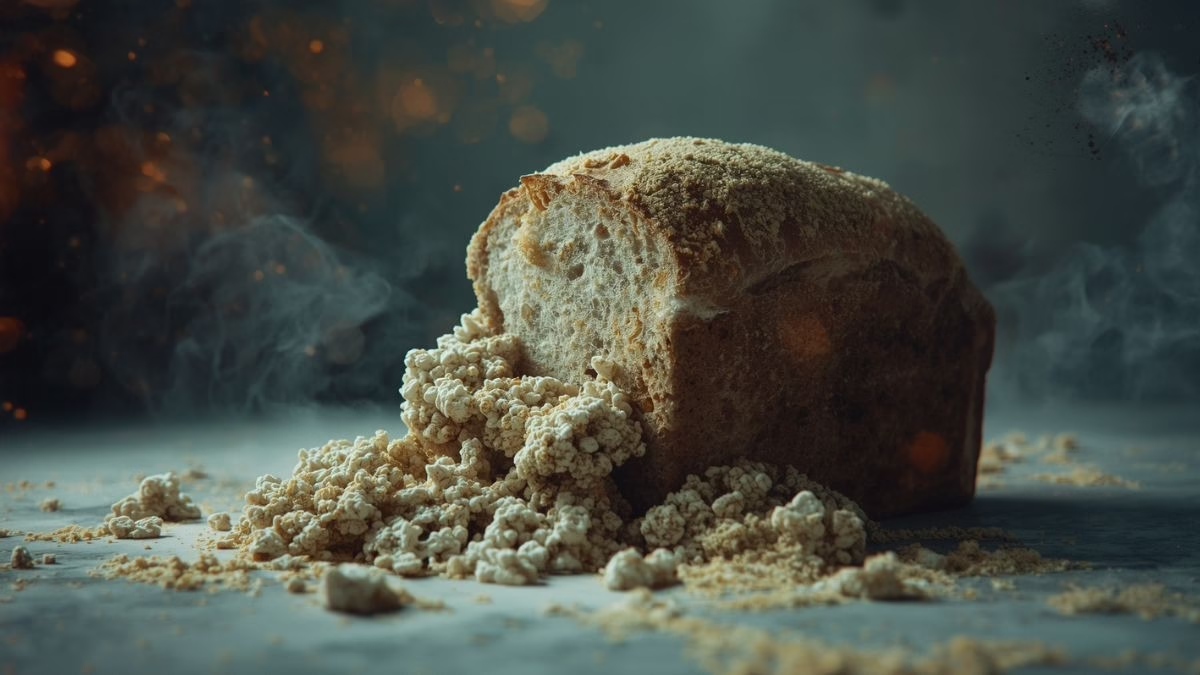Spark Discussion
What if I told you that your kitchen is the site of a constant, invisible war, and that beautiful, innocent-looking loaf of bread on your counter is the ultimate prize? It’s a story you know all too well. You buy a fresh loaf of sourdough or a bag of sandwich bread, full of optimistic plans for toast and sandwiches. Two days later, you reach for a slice and there it is: a small, sinister-looking spot of green or black fuzz. It seems to appear out of nowhere, with the sole purpose of ruining your breakfast and making you question your life choices. It feels like a personal attack. So, why does bread grow mold with such astonishing speed? The answer is that your loaf isn’t just sitting there going stale; it’s being actively colonized by an airborne army, and it just so happens to be the perfect paradise for these tiny invaders.
First off, let’s meet the enemy. What is this fuzzy stuff, anyway? Mold is not a plant or an animal; it’s a type of fungus, making it a cousin to mushrooms and yeast. And the key to its world domination strategy is its method of reproduction: spores. Think of mold spores as microscopic, lightweight seeds of destruction. They are fantastically resilient, and they are absolutely everywhere. They are floating in the air of your kitchen right now. They’re on your countertops, on your hands, and hitching a ride on the dust motes you see dancing in a sunbeam. These tiny commandos are constantly circulating, just waiting for the perfect opportunity, the perfect place to set up a new colony.
When one of these intrepid spores finally lands on a promising surface—like, say, a delicious slice of rye bread—it doesn’t just sit there. If the conditions are right, it germinates. It sends out tiny, transparent, root-like threads called hyphae (pronounced HY-fee). This is the really sneaky part of the invasion. These hyphae are the business end of the mold, burrowing deep into the bread, creating a vast, invisible network beneath the surface. They are essentially the mold’s digestive system, releasing enzymes that break down the bread into simple sugars that the mold can absorb as food. For days, this silent, underground invasion is happening completely out of your sight.
The fuzzy, colored patch you eventually see is the final, dramatic phase of the operation. Once the hyphae network is well-established and has absorbed enough nutrients, it sends up stalks called sporangiophores. The colored part on top of these stalks is the “fruiting body,” a microscopic factory that produces and releases millions upon millions of new spores into the air, ready to launch a fresh wave of attacks on the rest of your loaf and any other unsuspecting food in your kitchen. So that little green spot isn’t the beginning of the problem; it’s the grand finale of a successful colonization, the mold proudly planting its flag and raising its children on your sourdough.
This brings us to the big question: why bread? Why is it the five-star, all-inclusive resort for mold? It’s because bread offers the perfect package of everything a growing fungus could ever want. First, it’s an all-you-can-eat buffet. Bread is packed with carbohydrates—starches and sugars—which are a perfect, easily digestible food source. Second, it has just the right amount of moisture. Molds need water to thrive, and fresh bread’s soft, porous structure is like a sponge, trapping moisture and keeping the environment perfectly damp. And third, it lives in the perfect climate. Your kitchen counter, sitting at a comfortable room temperature, is the Goldilocks zone for mold growth—not too hot, not too cold. So, your loaf of bread is basically offering a delicious meal, plenty of water, and ideal weather. It’s the mold equivalent of a tropical vacation.
The plastic bag your bread comes in is a bit of a double-edged sword. On one hand, it does a great job of keeping the bread from drying out and going stale. On the other hand, by trapping all that moisture, it creates a wonderfully humid microclimate inside the bag—a personal greenhouse that tells the mold spores, “The party’s in here!” Sliced bread is even more susceptible because every single slice offers up a fresh, moist surface, and the very act of slicing can introduce spores from the knife or the air deep into the loaf, giving them a head start.
Naturally, this leads us to the great kitchen debate: should you put your bread in the refrigerator? The answer is… it’s complicated. Putting bread in the fridge will dramatically slow down the growth of mold. The cold temperature acts like a snooze button for the spores; they don’t die, but their metabolism slows to a crawl. So, yes, you will win the war against mold. However, you will lose the war against staleness. The cold, dry environment of the fridge accelerates a process called starch retrogradation, which is the scientific way of saying the starch molecules in the bread recrystallize and make it hard and dry much faster than it would on the counter. So you have a choice: fight mold (fridge) or fight staleness (counter). The true champion of bread preservation, by the way, is the freezer, which halts both processes in their tracks.
Now for the question every frugal person has asked while staring at a slightly fuzzy slice: “Can I just cut off the moldy bit and toast the rest?” I’m sorry to be the bearer of bad news, but the scientific consensus is a resounding “no.” Remember those invisible hyphae, the root network? The visible fuzzy spot is just the tip of the fungal iceberg. Those roots have likely spread far and deep throughout the slice, even if you can’t see them. Furthermore, some types of bread mold can produce something called mycotoxins, nasty chemical compounds that can make you sick. You can’t see them, taste them, or smell them, and toasting does not reliably destroy them. It’s just not worth the risk. The heartbreaking but wise advice is: if you spot mold, it’s best to toss the loaf.
Ultimately, this whole process isn’t just a kitchen annoyance; it’s a window into how the world works. Your bread isn’t just “going bad”; it’s participating in the grand circle of life. Mold is one of nature’s master recyclers, breaking down organic matter and returning its nutrients to the ecosystem. The same process that turns your bread into a fuzzy science experiment is what cleans up fallen logs in a forest. It’s a powerful, relentless, and vital force. It’s a reminder that even in our clean, modern kitchens, we are surrounded by a vibrant, invisible world, full of amazing and complex processes we take for granted.
Now that you know the secret life of bread mold, what other everyday kitchen mystery have you always wondered about? Why do apples turn brown? Why does popcorn pop? Share your questions in the comments below!










0 Comments